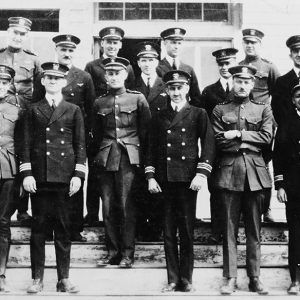calsfoundation@cals.org
Frank Robert McCrary (1879–1952)
Frank Robert McCrary was a pioneering U.S. Navy aviator who flew the service’s first dirigible and, though many of his greatest accomplishments occurred during peacetime, served in three wars.
Frank Robert McCrary was born on October 1, 1879, in Lonoke (Lonoke County), the son of William R. McCrary and Eugenia Witherspoon McCrary. He was an accomplished student, graduating as salutatorian from Lonoke Public High School in 1896. He was appointed to the U.S. Naval Academy at Annapolis, Maryland, the following year. While on summer leave, the young midshipman was sent to the Philippines during the Spanish-American War, the first of three conflicts in which he would serve. He graduated in 1901.
McCrary became an expert on torpedoes while leading the First Torpedo Flotilla early in his career, leading to an appointment as chief torpedo officer on the commanding staff of the Atlantic Fleet in 1913. On returning to the United States two years later, he was sent to the Goodyear plant in Akron, Ohio, for lighter-than-air (LTA) aircraft training; he subsequently became the first naval officer to qualify as a free balloon and LTA pilot. McCrary was one of three men who designed the Navy’s first LTA aircraft, with the contract for its construction going to the Connecticut Aircraft Company on June 1, 1915.
Construction of the aircraft, designated DN-1, was supposed to be complete by October 1915, but delays ranging from a lack of materials to a dearth of LTA engineering capability in both the Connecticut Aircraft Company and the Navy, led to it not being delivered to Pensacola Naval Air Station until December 1916. Lieutenant Commander McCrary served as test pilot for the dirigible, which failed miserably in three tests in early 1917. The airship was deflated and broken up.
McCrary also qualified as a heavier-than-air pilot, becoming Naval Aviator No. 91, and in 1917, he served as chief of the navy’s aeronautics bureau and was the second Director of Naval Aviation. He was the third navy pilot to land on an aircraft carrier at sea.
When World War I broke out, McCrary was sent to Ireland, where he commanded the navy’s air stations, overseeing the construction of four of them. He met Mary B. Davidson, a chief yeomanette (a naval petty officer who does clerical work), while there, and they became the only Americans who were permitted to marry in the Dublin Royal Naval Chapel. They had two sons and a daughter.
McCrary was awarded a Navy Cross “for distinguished and heroic service as Commanding Officer of a U.S. Naval Aviation Detachment in Ireland, during World War I.”
After the war, he commanded San Diego’s Naval Air Station North Island in 1921, and in 1924 he was the first commander of the USS Shenandoah, the first American-built rigid-frame airship, piloting the vessel from New York to San Diego, California. In 1926, McCrary was the captain of the USS Langley, the Navy’s first aircraft carrier, and in 1927 he again led North Island. In 1930, he commanded the aircraft carrier USS Saratoga before retiring from the navy as a captain in 1936. Over the course of his career, he had commanded eleven ships and five naval air stations.
His retirement was short lived. With World War II looming, he was re-called to active service, commanding Lakehurst Naval Air Station and later Alameda Naval Air Station, which would become Alameda Naval Air Center. He was awarded a Naval Commendation Medal for his World War II service, and he retired again in 1945.
McCrary died at the Oakland Naval Hospital on June 1, 1952. He is buried in Fort Rosecrans National Cemetery in San Diego.
For additional information:
“Capt. Frank Robert McCrary.” Find-A-Grave. https://www.findagrave.com/memorial/63552248/frank-robert-mccrary (accessed June 25, 2021).
Easley, Kristen Thomas. “Coronado’s ‘Avenue Of The Heroes’ … Capt. Frank Robert McCrary, USN.” Coronado Eagle and Journal, December 27, 2018. Online at http://www.coronadonewsca.com/news/coronado_city_news/coronado-s-avenue-of-the-heroes-capt-frank-robert-mccrary-usn/article_1e8c73c4-0a1e-11e9-8d05-bfeeda768cb5.html (accessed June 25, 2021).
“Former Navy Flier, Native of Lonoke, Dies in California.” Arkansas Gazette, June 14, 1952, p. 10.
“Frank Robert McCrary.” The Hall of Valor Project. https://valor.militarytimes.com/hero/9798 (accessed June 25, 2021).
Grossnick, Roy A., ed. From Kite Balloons to Airships … the Navy’s Lighter Than Air Experience. Washington DC: Government Printing Office, 2004.
“Lonoke Schools.” Arkansas Gazette, June 6, 1896, p. 4.
Recks, Robert. “McCRARY, Frank Robert.” Who’s Who of Ballooning. http://www.ballooninghistory.com/whoswho/who’swho-m1.html (accessed June 25, 2021).
“Rites Held for Navy Air Pioneer, Capt. McCrary.” Oakland Tribune, June 13, 1953, p. 34.
“U.S.S. Langley (CV1/AV3).” WW II History Collection. http://www.ww2historycollection.com/Weapons-Equipment/Weapons_Ships_USA_USSLangley.html (accessed June 25, 2021).
Mark K. Christ
Central Arkansas Library System
 Early Twentieth Century, 1901 through 1940
Early Twentieth Century, 1901 through 1940 Military
Military Shenandoah Crew
Shenandoah Crew 



Comments
No comments on this entry yet.